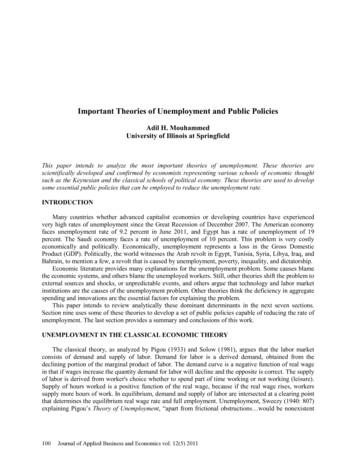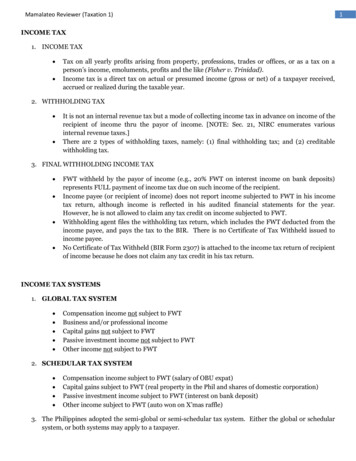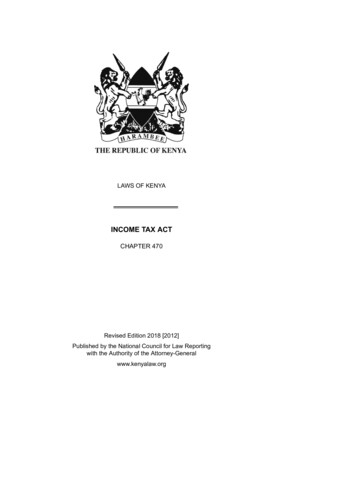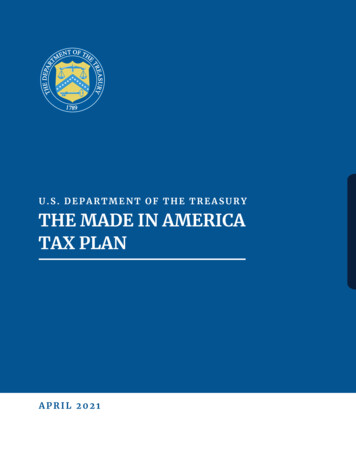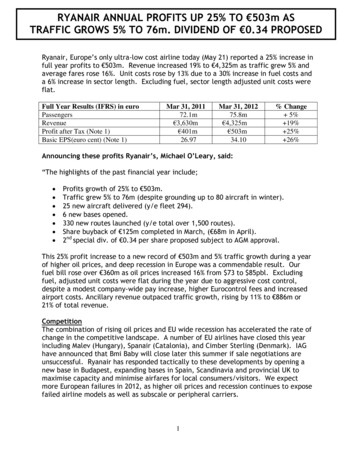
Transcription
RYANAIR ANNUAL PROFITS UP 25% TO 503m ASTRAFFIC GROWS 5% TO 76m. DIVIDEND OF 0.34 PROPOSEDRyanair, Europe’s only ultra-low cost airline today (May 21) reported a 25% increase infull year profits to 503m. Revenue increased 19% to 4,325m as traffic grew 5% andaverage fares rose 16%. Unit costs rose by 13% due to a 30% increase in fuel costs anda 6% increase in sector length. Excluding fuel, sector length adjusted unit costs wereflat.Full Year Results (IFRS) in euroPassengersRevenueProfit after Tax (Note 1)Basic EPS(euro cent) (Note 1)Mar 31, 201172.1m 3,630m 401m26.97Mar 31, 201275.8m 4,325m 503m34.10% Change 5% 19% 25% 26%Announcing these profits Ryanair’s, Michael O’Leary, said:“The highlights of the past financial year include; Profits growth of 25% to 503m.Traffic grew 5% to 76m (despite grounding up to 80 aircraft in winter).25 new aircraft delivered (y/e fleet 294).6 new bases opened.330 new routes launched (y/e total over 1,500 routes).Share buyback of 125m completed in March, ( 68m in April).2nd special div. of 0.34 per share proposed subject to AGM approval.This 25% profit increase to a new record of 503m and 5% traffic growth during a yearof higher oil prices, and deep recession in Europe was a commendable result. Ourfuel bill rose over 360m as oil prices increased 16% from 73 to 85pbl. Excludingfuel, adjusted unit costs were flat during the year due to aggressive cost control,despite a modest company-wide pay increase, higher Eurocontrol fees and increasedairport costs. Ancillary revenue outpaced traffic growth, rising by 11% to 886m or21% of total revenue.CompetitionThe combination of rising oil prices and EU wide recession has accelerated the rate ofchange in the competitive landscape. A number of EU airlines have closed this yearincluding Malev (Hungary), Spanair (Catalonia), and Cimber Sterling (Denmark). IAGhave announced that Bmi Baby will close later this summer if sale negotiations areunsuccessful. Ryanair has responded tactically to these developments by opening anew base in Budapest, expanding bases in Spain, Scandinavia and provincial UK tomaximise capacity and minimise airfares for local consumers/visitors. We expectmore European failures in 2012, as higher oil prices and recession continues to exposefailed airline models as well as subscale or peripheral carriers.1
Government RegulationDespite a rising number of airline failures and record airline losses, many of Europe’sgovernments continue to treat aviation (and airline passengers) as a cash cow to fundtheir taxation and/or policy failures. The UK and Germany have increased passengertaxes, which has damaged their traffic, tourism and job creation numbers. UK APDhas caused traffic to decline by 6% since 2007, while the UK Govt’s “do nothing”policy about runway capacity in the South East is encouraging traffic and tourism tobypass high cost London airports in favour of expanding airports in Spain, France, andHolland.Spain’s recent budget proposes significant increases in AENA’s already high airportcharges at Madrid and Barcelona, as well as smaller increases at other regionalSpanish airports. These Govt. imposed airport tax increases are in clear breach of theEU airport charges directive, and will further exacerbate youth unemployment inSpain. It is extraordinary at a time when the European Union is promoting growth,that individual EU governments wilfully ignore the reality that taxing air travel willdamage traffic, tourism and job creation, particularly in the weaker EU regions.In Ireland, the new Government after one year in office has so far delivered nochange or reform in the Dept of Transport’s failed policy of protecting the high costDAA airport monopoly. Traffic at the three DAA airports has declined 25% from 30M in2007 to 22M in 2011. At a time when Irish unemployment exceeds 14%, and youthemigration is rising, it’s time the new Irish Government adopted a radical reformpolicy including breaking up the three DAA airports, and selling one or both of the twoDublin airport terminals to raise funds for Government and allow competition deliverlower costs, traffic growth and jobs where the DAA monopoly and its downtown officethe Dept. of Transport has demonstrably failed.We expect the UK Court of Appeal will rule shortly in our “out of time” case, in whichwe are seeking to block the UK OFT investigating our 6 year old minority (29%) stakein Aer Lingus. This ruling will not end the issue as whoever loses will probably appealto the UK Supreme Court. Given the OFT’s recent failure to investigate IAG’s 100%acquisition of BMI, or its previous decision to ignore Air France’s 25% stake in Alitalia,it is impossible to understand why the OFT wishes to waste time or public fundsinvestigating a 6 year old failed merger between two non-UK airlines when the EUCommission has already ruled that Ryanair could not be required to sell down thisminority stake as it does not have either “de facto or de jure” control over AerLingus.EU State AidDespite the European Court dismissal of the Commission’s 2005 finding of State Aid inthe Charleroi case, and the Competition Commission’s failure to appeal this decision,it is clear that DG Comp is determined to pursue its misguided vendetta againstRyanair and our regional airports. DG Comp has now launched 18 separateinvestigations of (mainly) Ryanair traffic growth agreements at low cost regionalairports. While DG Comp wastes time and money trying to limit the growth of trafficand jobs at these regional airports, it continues to ignore its own failure to requireflag carrier airlines, to repay unlawful state aid in cases (incl. Air France, Malev,Spanair, and Alitalia among others) where the EU has ruled that illegal State Aid wasreceived. As the recent rubberstamping of more flag carrier airline mergers confirm,2
the EU Commission applies one set of rules for flag carriers but an entirely differentset of rules for Ryanair and our low cost regional airports all of whom comply fullywith the MEIP/State Aid rules.High Oil Prices.High oil prices continue to force competitors to increase fares and fuel surchargesmaking Ryanair’s fares even more attractive to consumers. Higher oil pricescontributed to the closure of Spanair and Malev, and will lead to further closures andrising losses. Ryanair is 90% hedged for FY13 at 1,011 per tonne (approx. 101 pbl),a 22% increase on last year but significantly lower than current prices. These higheroil prices next winter and the refusal of some monopoly airports (most notably Dublin& Stansted) to lower winter charges makes it more logical to ground up to 80 aircraftrather than suffer losses flying at very low winter yields in FY13.Balance Sheet.Ryanair’s balance sheet remains one of the strongest in the industry with over 3.5bnin cash despite having returned 1bn to shareholders over the past 5 years via 4 sharebuybacks and a 2010 special dividend of 0.34 per share. We have availed of lowinterest rates to secure almost 70% of our fleet financing all-in at under 3%. Our longterm Capex dollar hedging programme means that our remaining 11 Boeing deliveriesin late 2012 will be purchased at / exchange rate of 1.40, and we have alsoextended our FY 13 fuel hedges at / exchange rate of 1.38.Outlook.We expect traffic in FY13 will grow by 5% to just over 79m passengers. H1 traffic willgrow 7% while H2 will grow by 3%. Our fuel bill will rise by 320m in FY13 with mostof this increase skewed into H1, and as a result we expect to report a Q1 profit falldue to these higher prices. We remain concerned about next winter as we have zeroyield visibility but expect recession, austerity, currency concerns and lower fares atnew and growing bases in Hungary, Poland, Provincial UK, and Spain will make itdifficult to repeat this year’s record results. We expect that any increase in fareswill only partially offset higher fuel costs, and accordingly we are guiding net profit inFY13 subject to final yield outturn will be lower than FY12 in a range of between 400m to 440m.Dividend & Share buyback.In June 2010 we announced our first special dividend of 0.34 per share under whichwe returned almost 500m to shareholders. We believe it is opportune to propose asecond special dividend of 0.34 per share (approx. 483m) payable in Nov 2012subject to AGM approval. If paid, our 2nd special dividend will mean Ryanair hasreturned 1.53bn in dividends and share buybacks to shareholders over the past 5years”.ENDS.For further informationplease contact:www.ryanair.comHoward MillarRyanair Holdings plcTel: 353-1-81212123Joe CarmodyEdelmanTel: 353-1-6789333
Note 1: March 2012 excludes an exceptional item of 57.8m, net of tax, relating to a one off release ofticket sales revenue due to a change in accounting estimates arising from enhancements to our revenueaccounting systems. Exceptional items in the year ended 31 March, 2011 amounted to 26.1m (net oftax) from the estimated costs relating to he closure of airspace in April and May 2010 due to theIcelandic volcanic ash disruptions.Certain of the information included in this release is forward looking and is subject toimportant risks and uncertainties that could cause actual results to differ materially. It isnot reasonably possible to itemise all of the many factors and specific events that couldaffect the outlook and results of an airline operating in the European economy. Amongthe factors that are subject to change and could significantly impact Ryanair’s expectedresults are the airline pricing environment, fuel costs, competition from new and existingcarriers, market prices for the replacement aircraft, costs associated with environmental,safety and security measures, actions of the Irish, U.K., European Union (“EU”) and othergovernments and their respective regulatory agencies, weather related disruptions,fluctuations in currency exchange rates and interest rates, airport access and charges,labour relations, the economic environment of the airline industry, the general economicenvironment in Ireland, the UK and Continental Europe, the general willingness ofpassengers to travel and other economics, social and political factors.Ryanair is the World’s favourite airline and operates more than 1,500 flights per day from51 bases and 1,500 low fare routes across 28 countries, connecting over 165 destinations.Ryanair operates a fleet of 294 new Boeing 737-800 aircraft with firm orders for a further 11new aircraft (before taking account of planned disposals), which will be delivered over thenext year. Ryanair currently has a team of more than 8,500 people and expects to carry 79million passengers in the current fiscal year.4
Ryanair Holdings plc and SubsidiariesCondensed Consolidated Preliminary Balance Sheet as at March 31, 2012At Mar 31,2012 MAt Mar 31,2011 18.4Current assetsInventoriesOther assetsCurrent taxTrade receivablesDerivative financial instrumentsRestricted cashFinancial assets: cash 3monthsCash and cash equivalentsTotal current 799.40.550.6383.842.9869.42,028.33,477.6Total assets9,001.08,596.0Current liabilitiesTrade payablesAccrued expenses and other liabilitiesCurrent maturities of debtDerivative financial instrumentsTotal current 3336.7125.41,837.2Non-current liabilitiesProvisionsDerivative financial instrumentsDeferred taxOther creditorsNon-current maturities of debtTotal non-current oteNon-current assetsProperty, plant and equipmentIntangible assetsAvailable for sale financial assetsDerivative financial instrumentsTotal non-current assets118Shareholders' equityIssued share capitalShare premium accountCapital redemption reserveRetained earningsOther reservesShareholders' equity131313Total liabilities and shareholders' equity5
Ryanair Holdings plc and SubsidiariesCondensed Consolidated Preliminary Income Statement for the year ended March 31, 2012PreExceptional ExceptionalResultsItemsMar 31,Mar 31,20122012Note M MOperating revenuesScheduled revenuesAncillary revenuesTotal operating revenues - continuing operationsOperating expensesStaff costsDepreciationFuel & oilMaintenance, materials & repairsAircraft rentalsRoute chargesAirport & handling chargesMarketing, distribution & otherIcelandic volcanic ash related costsTotal operating expensesOperating profit - continuing operationsOther income/(expenses)Finance incomeFinance expenseForeign exchange gain/(loss)Gain on disposal of property, plant andequipmentTotal other expensesProfit before taxTax on profit on ordinary activitiesProfit for the year - all attributable to equityholders of parentEarnings per ordinary share (in cent)BasicDilutedWeighted average no. of ordinary shares (in Ms)BasicDiluted1124IFRSYearEndedMar 31,2012 MPreExceptionalResultsMar 31,2011 MExceptionalItemsMar 31,2011 MIFRSYearEndedMar 31,2011 473.71,477.01,485.71,490.11,485.71,490.16
Ryanair Holdings plc and SubsidiariesCondensed Consolidated Preliminary Statement of Comprehensive Income for theyear ended March 31, 2012YearEndedMar 31,2012 MYearEndedMar 31,2011 M560.4374.6(6.3)5.0(117.5)197.135.7(2.2)Other comprehensive (loss)/income for the year, net of income tax(88.1)199.9Total comprehensive income for the year – all attributable to equity holders of Parent472.3574.5Profit for the yearOther comprehensive income:Net actuarial (loss)/gain from retirement benefit plansCash flow hedge reserve movements:Net movement (out of)/into cash flow hedge reserveAvailable for sale financial asset:Net increase/(decrease) in fair value of available for sale financial asset7
Ryanair Holdings plc and SubsidiariesCondensed Consolidated Preliminary Statement of Cash Flows for the year ended March 31,2012YearEndedMar 31,2012 MYearEndedMar 31,2011 M633.0420.9Adjustments to reconcile profit before tax to net cash provided by operating activitiesDepreciation(Increase) in inventories(Increase) in trade receivablesDecrease/(increase) in other current assetsIncrease/(decrease) in trade payablesIncrease in accrued expensesIncrease/(decrease) in other creditorsIncrease/(decrease) in provisions(Gain) on disposal of property plant and equipmentDecrease in finance expenseIncrease in finance incomeRetirement costsShare based paymentsIncome tax (paid)Net cash provided by operating g activitiesCapital expenditure (purchase of property, plant and equipment)Decrease in restricted cashDecrease in financial assets: cash 3monthsNet cash used in investing 4.0)Financing activitiesNet proceeds from shares issuedDividend paidProceeds from long term borrowingsRepayments of long term borrowingsShares purchased under share buyback programmeNet cash provided by financing 028.3Operating activitiesProfit before tax13Increase in cash and cash equivalentsCash and cash equivalents at beginning of the yearCash and cash equivalents at end of the year8
Ryanair Holdings plc and SubsidiariesCondensed Consolidated Preliminary Statement of Changes in Shareholders’ Equity for theyear ended March 31, 2012Other ReservesBalance at March 31, 2010Profit for the yearOther comprehensive incomeNet actuarial gains from retirementbenefit plansNet movements into cash flowreserveNet change in fair value ofavailable for sale financial assetTotal other comprehensive incomeTotal comprehensive incomeTransactions. with owners of theCompany, recognised directly inequityIssue of ordinary equity sharesShare-based paymentsDividend paidTransfer of exercised and expiredshare based awardsBalance at March 31, 2011Profit for the yearOther comprehensive incomeNet actuarial gains from retirementbenefit planNet movements into cash flowreserveNet change in fair value ofavailable for sale financial assetTotal other comprehensive incomeTotal comprehensive incomeTransactions with owners of theCompany recognised directly inequityIssue of ordinary equity sharesRepurchase of ordinary equity sharesCancellation of repurchased ordinarysharesShare-based paymentsTransfer of exercised and expiredshare based awardsBalance at March 31, 2012IssuedOrdinary ShareShares CapitalM M1,478.99.4-ShareCapitalPremium Retained RedemptionAccount EarningsReserve M M M631.92,083.50.5374.6-Hedging M60.3-OtherReserves M63.0-Total 455.69.3666.43.02,400.10.7139.9(3.0)91.63,308.09
Ryanair Holdings plc and SubsidiariesOperating and Financial OverviewIntroductionFor the purposes of the Management Discussion and Analysis (“MD&A”) all figures and comments are by referenceto the adjusted income statement excluding the exceptional items referred to below. A reconciliation of the resultsfor the year under IFRS to the pre exceptional results is provided in Note 9.The exceptional item in the year relates to a one-off release of ticket sales revenue in the year ended March 31, 2012of 57.8m, net of tax, due to a change in accounting estimates arising from enhancements to our RevenueAccounting Systems. Exceptional items in the year ended March 31, 2011 amounted to a net of tax charge of 26.1mfor the estimated costs relating to the closure of airspace in April and May 2010 due to the Icelandic volcanic ashdisruptions.Profit after tax in the year ended March 31, 2012 increased by 25% to 502.6m compared to adjusted profit after taxin the year ended March 31, 2011. Including exceptional items, the profit after tax for the year increased by 50%from 374.6m to 560.4m.Summary year ended March 31, 2012Adjusted profit after tax increased by 25% to 502.6m compared to 400.7m in the year ended March 31, 2011primarily due to a 16% increase in average fares and strong ancillary revenues, offset by a 30% increase in fuelcosts. Total operating revenues increased by 19% to 4,324.9m as average fares rose by 16%. Ancillary revenuesgrew by 11%, faster than the 5% increase in passenger numbers, to 886.2m due to an improved product mix andhigher internet related revenues. Total revenue per passenger, as a result, increased by 13% whilst Load Factordecreased by 1 point to 82% during the year.Total operating expenses increased by 19% to 3,707.0m, primarily due to an increase in fuel prices, the higherlevel of activity and operating costs associated with the growth of the airline. Fuel, which represents 43% of totaloperating costs compared to 39% in the prior year, increased by 30% to 1,593.6m due to the higher price per gallonpaid and an 11% increase in the number of hours flown. Unit costs excluding fuel increased by 6% and sectorlength adjusted, they remained flat. Including fuel unit costs rose by 13%. Operating margin remained flat at 14%whilst operating profit increased by 20% to 617.9m.Adjusted net margin was up 1 point to 12%, compared to March 31, 2011.Adjusted basic earnings per share for the year were 34.10 euro cent compared to adjusted basic earnings per shareof 26.97 euro cent at March 31, 2011.Balance sheetGross cash increased by 575.0m since March 31, 2011 to 3,515.6m. The Group generated cash from operatingactivities of 1,020.3m which funded net capital expenditure of 290.4m, debt repayments and a 124.6m share buyback programme. Gross debt decreased by 24.2m to 3,625.2m. Net debt has fallen from 708.8m at March 31,2011 to 109.6m at the year end.10
Detailed Discussion and Analysis for the year ended March 31, 2012Adjusted profit after tax increased by 25% to 502.6m primarily due to a 16% increase in average fares and strongancillary revenues offset by higher fuel costs. Total operating revenues increased by 19% to 4,324.9m primarilydue to a 16% increase in average fares, and a 5% increase in passenger numbers. Fuel, which represents 43% oftotal operating costs compared to 39% in the prior year, increased by 30% to 1,593.6m due to a higher price pergallon paid and an 11% increase in the number of hours flown. Unit costs excluding fuel rose by 6%, and sectorlength adjusted they remained flat. Including fuel unit costs rose by 13%. Operating margin, as a result of theabove, remained flat at 14%, whilst operating profit increased by 20% to 617.9m.Total operating revenues increased by 19% to 4,324.9m primarily due to a 16% increase in average fares and a5% increase in passenger numbers to 75.8m.Total revenue per passenger increased by 13% primarily due to a 16% increase in average fare per passenger.Scheduled passenger revenues increased by 22% to 3,438.7m due to a 5% rise in passengers and a 16% increasein average fares. Load factor decreased by 1 point to 82%.Ancillary revenues increased by 11% to 886.2m, faster than the 5% increase in passenger volume, due to animproved product mix and higher internet related revenues.Total operating expenses increased by 19% to 3,707.0m due to the 30% increase in fuel costs and a 6% increasein sector length.Staff costs increased by 12% to 415.0m due to an 11% increase in hours flown and a companywide pay increase of2% granted in April 2011.Depreciation and amortisation increased by 13% to 309.2m due to a combination of the increased level ofactivity and a higher number of ‘owned’ aircraft in the fleet this year (March 31, 2012: 235) compared to the yearended March 31, 2011 (221).Fuel & oil costs increased by 30% to 1,593.6m due to higher fuel prices and the increased number of hours flown.Maintenance costs increased by 11% to 104.0m due to the increased level of activity and higher costs arising fromthe launch of new bases.Aircraft rental costs fell by 5% to 90.7m, due to lower lease costs on newer aircraft and the handback of 3 aircraftdue to the maturity of leases.Route charges rose by 12% to 460.5m due to the increased number of sectors flown, the longer sector length andhigher average rates charged by Eurocontrol.Airport & handling charges increased by 13% to 554.0m, due to the 5% increase in passenger volumes, higherairport charges at Dublin airport, increased airbridge charges in Spain, and the mix of new routes and baseslaunched.11
Marketing, distribution & other costs increased by 19% to 180.0m, reflecting higher marketing spend perpassenger due to increased activity and increased onboard product costs reflecting the higher level of sales.Operating margin remained flat at 14% due to the reasons outlined above and operating profits have increased by20% to 617.9m.Finance income increased by 62% to 44.3m primarily due to improved yields on term deposits.Finance expense increased by 18% to 109.2m primarily due to higher interest rates in the year compared to theyear ended March 31, 2011.Adjusted net margin was up 1 point to 12%, compared to March 31, 2011.Balance sheetGross cash increased by 575.0m to 3,515.6m and the Group generated cash from operating activities of 1,020.3m which funded net capital expenditure of 290.4m, debt repayments and a 124.6m share buy backprogramme. Gross debt decreased by 24.2m to 3,625.2m. Net debt has fallen from 708.8m at March 31, 2011to 109.6m at the year end.Shareholders’ equity increased by 354.1m in the year to 3,308.0m due to the net profit after tax of 560.4m andthe issue of new shares, associated with the employee share option programme, of 7.1m. These were offset by the 124.6m share buy back and the impact of IFRS accounting treatment for derivatives and pensions, available for salefinancial assets and employee share options.12
Ryanair Holdings plcNotes forming Part of the Condensed ConsolidatedPreliminary Financial Statements1.Basis of preparation and significant accounting policiesRyanair Holdings plc (the “Company”) is a company domiciled in Ireland. The unaudited condensedconsolidated preliminary financial statements of the Company for the year ended March 31, 2012 comprise theCompany and its subsidiaries (together referred to as the “Group”).These unaudited condensed consolidated preliminary financial statements (“the preliminary financialstatements”), which should be read in conjunction with our 2011 Annual Report, have been prepared inaccordance with International Accounting Standard No. 34 “Interim Financial Reporting” as adopted by the EU(“IAS 34”). They do not include all of the information required for full annual financial statements, and shouldbe read in conjunction with the most recent published consolidated financial statements of the Group. Theconsolidated financial statements of the Group as at and for the year ended March 31, 2011 are available atwww.ryanair.com.The comparative figures included for the year ended March 31, 2011 do not constitute statutory financialstatements of the Group within the meaning of Regulation 40 of the European Communities (Companies, GroupAccounts) Regulations, 1992. Statutory financial statements for the year ended March 31, 2011 have been filedwith the Companies’ Office. The auditors’ report on those financial statements was unqualified.The Audit Committee, upon delegation of authority by the Board of Directors, approved the preliminaryfinancial statements for the year ended March 31, 2012 on May 18, 2012.Except as stated otherwise below, this period’s financial information has been prepared in accordance with theaccounting policies set out in the Group’s most recent published consolidated financial statements, which wereprepared in accordance with IFRS as adopted by the EU and in compliance with IFRS as issued by theInternational Accounting Standards Board.There were no new standards, interpretations or amendments to existing standards adopted for the first time inthe year ended March 31, 2012, which would have a material impact on our financial position or results fromoperations.The following new or revised IFRS standards and IFRIC interpretations will be adopted for purposes of thepreparation of future financial statements, where applicable. We do not anticipate that the adoption of these newor revised standards and interpretations will have a material impact on our financial position or results fromoperations. Amendments to IFRS 7 “Disclosures – Transfers of Financial Assets” (effective for fiscal periodsbeginning on or after July 1, 2011). Amendments to IAS 12 “Deferred Tax: Recovery of Underlying Assets” (effective for fiscalperiods beginning on or after January 1, 2012). IAS 1 (amendment 2011) “Presentation of items of other comprehensive income” (effective forfiscal periods beginning on or after July 1, 2012). IFRS 10, “Consolidated Financial Statements” (effective for fiscal periods beginning on or afterJanuary 1, 2013). IAS 19 (amendment 2011) “Employee benefits” (effective for fiscal periods beginning on or afterJanuary 1, 2013).13
IFRS 11, “Joint Arrangements” (effective for fiscal periods beginning on or after January 1,2013). IFRS 12, “Disclosure of Interests in other Entities” (effective for fiscal periods beginning on orafter January 1, 2013). IFRS 13, “Fair Value Measurement” (effective for fiscal periods beginning on or after January 1,2013). IAS 27 (amended 2011) “Separate Financial Statements” (effective for fiscal periods beginningon or after January 1, 2013). IAS 28 (amended 2011) “Investments in Associates and Joint Ventures” (effective for fiscalperiods beginning on or after January 1, 2013). Amendments to IFRS 7: “Disclosures – Offsetting Financial Assets and FinancialLiabilities” (effective for fiscal periods beginning on or after 1 January 2013). Offsetting Financial Assets and Financial Liabilities (Amendment to IAS 32): (Effective for fiscalperiods beginning on or after 1 January 2014). IFRS 9 Financial Instruments (IFRS 9 (2010)) –effective from1 January 2015. (Effective forfiscal periods beginning on or after 1 January 2015).Exceptional itemsThe Company presents certain items separately, which are unusual, by virtue of their size and incidence, in thecontext of our ongoing core operations, as we believe this presentation represents the underlying business moreaccurately and reflects the manner in which investors typically analyse the results.Any amounts deemed“exceptional” for management discussion and analysis purposes have been classified for the purposes of the IFRSincome statement in the same way as non exceptional amounts of the same nature.During 2012, changes in estimates relating to the timing of revenue recognition for unused passenger tickets weremade, resulting in increased revenue in the current year of 65.3m (pre tax). This change reflects more accurate andtimely data obtained through system enhancements.In the prior period we have presented the estimated costs relating to the closure of European airspace due to theIcelandic volcanic ash disruptions as an exceptio
Ryanair, Europe’s only ultra-low cost airline today (May 21) reported a 25% increase in full year profits to 503m. Revenue increased 19% to 4,325m as traffic grew 5% and average fares rose 16%. Unit costs rose by 13% due to a 30% increase in fuel costs and a 6% increase in sector leng
